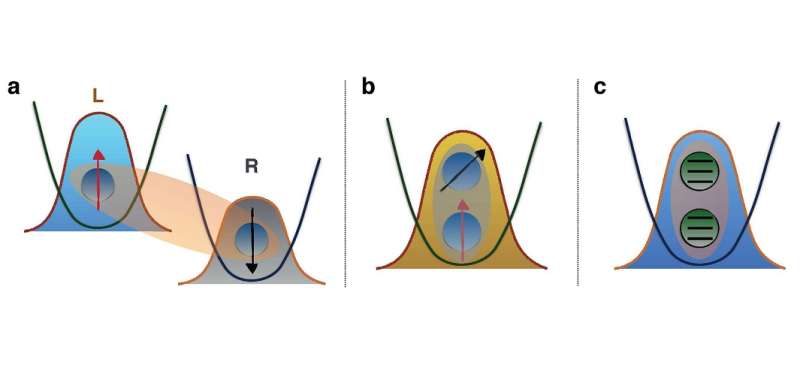March 27, 2017 report
Physicists settle controversy over identical particle entanglement

(Phys.org)—In a new study, physicists have shown a way to establish real entanglement between two identical particles—a topic that has been disputed until now. The results provide a better understanding of the fundamental nature of entanglement between identical particles and have potential applications in quantum information processing.
One of the many strange features of quantum entanglement is that, if two particles are identical, then they automatically appear to be entangled. In this case, "identical" means that the particles are of the same type—for example, any two photons are considered identical because there is no way to tell any particular photon apart from another.
This type of entanglement, which physicists call "entanglement due to indistinguishability," arises because of the standard way that identical particles are labeled. Although the particles are identical, physicists assign them different labels in order to tell them apart. Because of the way that entanglement is determined, with respect to their labels, identical particles inevitably appear to be entangled.
Although this type of entanglement is different than entanglement between non-identical particles, there is disagreement among physicists over what exactly it is and whether or not it is useful for applications. In one viewpoint, the entanglement holds even for distant particles but cannot be exploited for practical use. In another viewpoint, the entanglement is simply an artifact of labeling and should not really be considered entanglement at all.
Ideally, an appropriate way to settle the debate would be to investigate the entanglement between identical particles using a process called Schmidt decomposition, which is commonly used to study entanglement between non-identical particles. Unfortunately, Schmidt decomposition doesn't apply to identical particles in a straightforward way, and its use in this area has been controversial and inaccurate, giving obviously incorrect results for identical particles.
The main result of the new study is that the physicists have generalized Schmidt decomposition so that it can be applied to identical particles equally as well as non-identical particles.
"The results show that entanglement between identical particles is not merely a mathematical artifact, but that, under certain conditions, the entanglement due to indistinguishability is true physical entanglement," coauthor Rosario Lo Franco at the University of Palermo, Italy, told Phys.org.
When applied to two identical qubits, the method shows that, in certain situations, particles can be physically entangled only when in close proximity, and not when spatially separated as it previously appeared.
"The key to the achievement was to do away with the standard practice of assigning labels to identical particles, and instead simply describe the particles in terms of their states," said coauthor Giuseppe Compagno at the University of Palermo.
The researchers also discovered a somewhat surprising result for qutrits—three-level particles which are relevant for storing quantum information—that contrasts with a previous result using a different method. The researchers said that this difference requires further investigation.
Overall, the physicists expect the method to provide a new type of entanglement resource for applications.
"In the case where the particle wave functions overlap, entanglement due solely to indistinguishability and unveiled directly by the Schmidt decomposition can be utilized operationally in protocols of quantum information processing," Lo Franco said. "This achievement may first require a separation of the identical particles as obtained by the so-called extraction procedures."
More information: Stefania Sciara, Rosario Lo Franco, and Giuseppe Compagno. "Universality of Schmidt decomposition and particle identity." Scientific Reports 7, 44675 (2017). DOI: 10.1038/srep44675
Journal information: Scientific Reports
© 2017 Phys.org



















